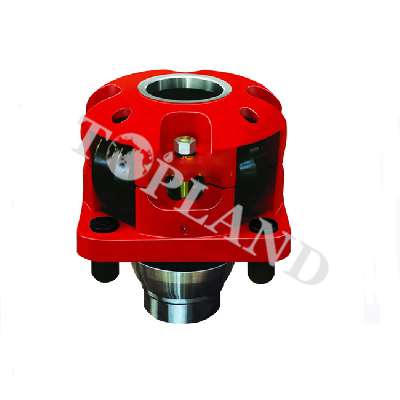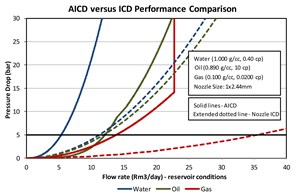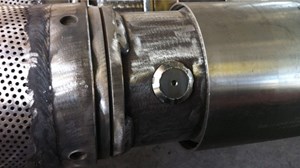ONS 2021: THE SYNERGY BETWEEN SAND CONTROL SCREENS AND INFLOW CONTROL DEVICES
In the pursuit of additional hydrocarbon reserves and increased oil production, operators continue to look to challenging reservoirs, such as the high permeability, high productivity, clastic reservoirs that can be found in hydrocarbon basins around the world. The use of high deviation and horizontal trajectories in these wells has increased the amount of reservoir contacted by the wellbore, improving well productivity, and to some extent, reducing the potential for sand production by reducing the overall drawdown on the formation.
To ensure the integrity of the wells and prevent sand production, operators turn to a variety of sand control methods, including gravel packs, frac packs, slotted liners and screens. A properly conceived and executed sand control strategy can be very effective in reducing or eliminating solid production without unduly restricting productivity. The effectiveness of these methods can be improved with the addition of flow control devices, such as Inflow Control Devices (ICDs) and Autonomous Inflow Control Devices (AICDs), which moderate and control the flow of fluids from the reservoir along the length of the wellbore. The use of these devices can improve the reliability of the sand control methods, as well as improve sweep efficiency and hydrocarbon recovery.
Horizontal Wells, Sand Control and ICDs
Horizontal wells provide significantly greater reservoir contact in comparison to vertical wells and, as a result, can produce more oil and gas with a lower draw down pressure along the wellbore. While long horizontal wells can increase the productivity and recovery of oil by increasing reservoir contact, uneven production due to reservoir heterogeneity, varying permeability, saturation or frictional pressure losses along the length of the horizontal bore can lead to early water or gas breakthrough in parts of the wellbore. The production of unwanted effluents negatively impacts oil flow from the rest of the well. Water influx can produce high fluid velocity and viscous drag in the formation matrix, dissolve the minerals cementing the grains, and cause an increase in sand production.
ICDs, which restrict flow by creating additional, flow rate dependent pressure drop, have been used for several years to balance production flux and mitigate such problems. However, they are passive in nature and, once installed, cannot be adjusted. In the event that water or gas breaks through in one part of an oil well, the passive ICD is unable to counter the effects of the higher mobility of these fluids in the reservoir, increasing flow rates and overwhelming the oil production from the well.
A relatively recent technological breakthrough in this area has been the development of autonomous inflow control devices (AICDs). These are self-regulating flow control devices that have the ability to change the amount of flow restriction based on the properties of the fluid flowing through them. Unlike passive ICDs, which produce greater flow restriction for fluids with higher viscosity, the AICD can restrict water and gas more readily than oil. This ability allows for even more oil flow from all segments of the wellbore and prevents excessive production of unwanted fluids from segments that have experienced breakthrough of water or gas. Ultimately, this capability results in greater oil recovery with a lower water cut and lower gas oil ratio.
One type of AICD, a levitating disc-based valve from Tendeka, has been deployed successfully in more than 75 wells globally with more than 15,000 valves in light and heavy oil reservoirs to overcome water or gas breakthrough and ensure uniform production. The valve, which operates through adapting to changes in fluid viscosity, preferentially restricts the flow of low viscosity unwanted water and gas whilst promoting the production of oil from the entire length of the well. The greater restriction of low viscosity fluid is created by the movement of the disk to create a smaller flow area through the AICD and hence, a greater flow restriction.
Both ICDs and AICDs are easily integrated with conventional screen and premium screen technology. Flow from the reservoir enters the annular area between the wellbore and screen, passes through the screen and moves in the space between the screen and the unperforated base pipe to a housing containing one or more of the flow control devices. The fluid then passes through the flow control device, entering the production conduit to surface.
Synergy between AICDs and Sand Control
The use of screens with ICDs and AICDs is complementary. Screens have been used not only to prevent sand production, but also to prevent larger debris from plugging the ports and channels in the flow control devices. Careful attention to sizing of the screens ensures that whatever solids and fines are able to pass through the screens will not obstruct the ICD and AICD completion, verified by flow loop testing with solids laden fluid and slurries.
The even distribution of flow encouraged by flow control devices reduces the chance of developing flow “hot spots,” which may erode screens and other completion equipment. Restriction of flow along the length of the wellbore prevents excessive velocity of fluids moving through the reservoir matrix in the near wellbore region and balance the draw down pressure on the reservoir. These effects reduce two of the three main forces contributing to the stresses that can exceed the formation shear strength and cause sand production. Specific to AICDs, the ability to restrict the production of unwanted effluents reduces the potential for dissolution by produced water of cementing minerals in the reservoir matrix, and prevention of high drag forces from excessive fluid velocities brought on by gas break through.
Proven Benefits
An example of where Tendeka’s AICDs have been successfully deployed is on Troll field, offshore Norway. The AICD is incorporated with premium screen to provide sand control and inflow control for a thin layer oil rim of between 11 to 26 m. In the early years, passive ICDs were employed in the field; however, once gas breakthrough occurred the high mobility of the gas rapidly dominated the flow in the well. A 20% increase in cumulative oil production was recorded in the AICD completion trial well within the first 18 months of production in comparison to a passive ICD equivalent.
Conclusions
AICDS are enabling production engineers to manage reservoir flow in horizontal wells with better flow assurance and greater oil recovery. The ability to restrict low viscosity unwanted water and gas results in lower water cut and reduced gas oil ratio. In addition, the synergy between AICDs and screens is a significant and beneficial method to reduce sand production caused by excessive drawdown, high fluid flow drag forces, and dissolution of cementation in poorly consolidated reservoirs.




 Upload RFQ
Upload RFQ







 Twitter
Twitter Linkedin
Linkedin Facebook
Facebook YouTube
YouTube Sales@toplandoil.com
Sales@toplandoil.com +86 21-50890868
+86 21-50890868 Head Office: 8-1011,Lane 5600, Chuansha Road, Pudong, Shanghai, China
Head Office: 8-1011,Lane 5600, Chuansha Road, Pudong, Shanghai, China 